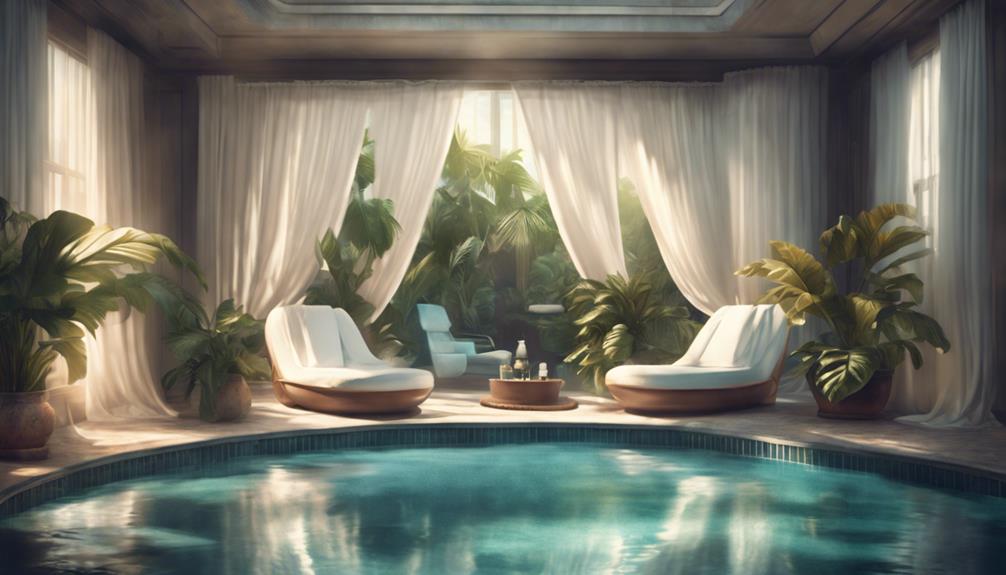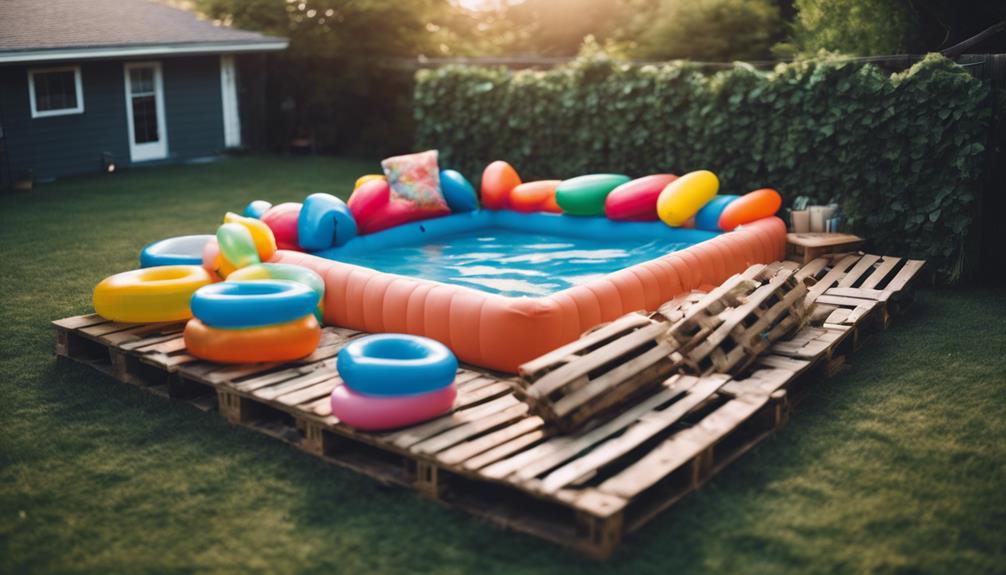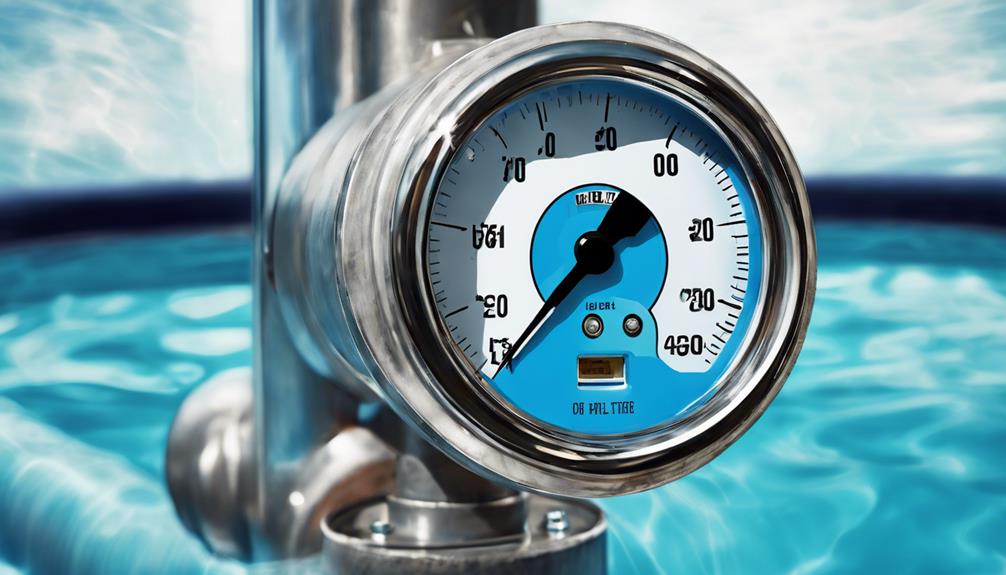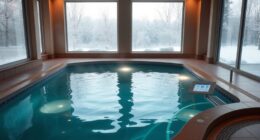Have you ever noticed how swimming pool water appears so blue and inviting? Well, here’s the explanation! When sunlight touches the water, it interacts with the molecules by absorbing red light and reflecting blue light from the sky. Furthermore, the materials used in the pool’s construction, such as blue tiles or fiberglass, can intensify this cool blue effect. The depth of the water and surrounding elements also contribute to the blue hue. Interested in learning more about the science behind why pool water looks blue? There is a wealth of fascinating details to explore!
Key Takeaways
- Sunlight interaction with water molecules causes blue color.
- Absorption of red light by water enhances blue hue.
- Reflection of the sky's blue hue contributes to water color.
- Blue tiles and fiberglass enhance the classic blue appearance.
- Proper maintenance and materials maintain the pool's blue hue.
Light and Water Interaction
When sunlight hits the water, it interacts with the water molecules, creating that beautiful blue hue you see in swimming pools. It's like a magic show between the light and the water! You see, sunlight is a mix of all the colors in the rainbow. But when it enters the water, the water molecules start playing favorites and absorb the red light, leaving behind the blue tones for us to admire.
So, why does the pool water look blue? Well, it's because when light bounces off the water's surface, it's missing that warm red glow. Without the red light, the reflection appears blue to our eyes. It's like the water is saying, 'Sorry, no red light here, just cool blues!'
Even artificial lighting can join in on the fun, especially in deeper pools where the blue effect is more pronounced.
Pool Construction Materials

Sunlight interacting with the water in a swimming pool creates a beautiful blue hue, enhanced by the choice of blue tiles or fiberglass in the pool construction materials. When it comes to creating that classic blue pool look, the materials used play an essential role.
Imagine those shimmering blue tiles or that sleek fiberglass lining your pool; they aren't just there for looks – they're the magic behind the scenes. Blue tiles and fiberglass are like the unsung heroes of swimming pools, working hard to maintain that consistent blue that we all love. It's like they're saying, 'Hey, let's keep this pool looking cool and inviting.'
Reflection of the Sky

Ever noticed how swimming pool water seems to match the color of the sky above? That's because pools reflect the sky's blue hue, giving them that cool, invigorating look.
It's like a fun optical illusion, where the water mirrors the sky's color, making everything seem extra serene and inviting.
Sky's Color Impact
Reflecting the blue hue of the sky, swimming pool water often appears blue due to this mirroring effect. It's like the pool is taking on the sky's color and showing off its own version of blue!
When you gaze at a pool on a sunny day, the water's blue color isn't just a random choice; it's actually influenced by the sky's color above. As the sunlight hits the water, it absorbs all the colors from the spectrum but reflects the blue wavelengths back to our eyes, creating that invigorating and revitalizing blue appearance.
Optical Illusion Effect
The optical illusion effect created by the reflection of the sky onto swimming pool water is what gives it the appearance of a vibrant blue hue. When you look at a pool, the water isn't actually blue itself; it's just expertly reflecting the blue sky above. It's like a magic trick nature plays on us, making us think the water is a different color than it really is. Check out the table below to see how this optical illusion works:
| Fact | Description | Impact |
|---|---|---|
| Reflection of the blue | The sky's blue color reflects on the water surface | Creates the blue illusion |
| Illusion effect | Trickery of our eyes making water appear blue | Enhances the pool's vibe |
| Optical illusion | Deceptive appearance due to sky's reflection | Adds to the pool's allure |
| Connection to sky's reflection | Sky's color influencing the pool water's appearance | Enhances the visual appeal |
Absorption and Reflection of Light

Ever wondered why swimming pool water looks so blue?
Well, it all comes down to how water molecules interact with light. When sunlight hits the water, it absorbs the warm tones like red and orange, leaving behind those cool, calming blues.
Understanding this interplay between light and water molecules reveals the magic behind the mesmerizing blue hue of swimming pools.
Light Absorption Mechanism
Imagine this: when sunlight interacts with water molecules in swimming pools, the absorption of red wavelengths leads to the reflection of blue light. It's like a cool magic trick happening right in your backyard!
Visualize this: the water molecules in the pool are like tiny sponges soaking up all the red light from the sun. They're saying, 'Nope, we don't want red here!' So, they take in the red end of the light spectrum and bounce back the blue light instead.
That's why when you look at a pool, you see that beautiful blue effect.
Reflection in Pool Water
Understand how light interacts with pool water to create its distinctive blue appearance through a process of absorption and reflection. When sunlight hits the water, the molecules in the pool absorb the red wavelengths while reflecting the blue ones. It's like the water is saying, 'Bye-bye red, hello blue!' This absorption of red light is what gives pool water its cool, invigorating blue color that we all love to splash around in.
But wait, there's more! The color of the sky and the surroundings can also play a part in how we perceive the water's color. So, if the sky is looking all blue and beautiful, it can make the pool water seem even bluer. It's like the water is trying to match its surroundings, saying, 'I see you, sky, and I raise you some extra blue!'
And let's not forget how blue tiles or finishes in a pool can dial up that natural blue vibe, making the water look even more inviting. So next time you take a plunge, remember, it's all about that red light getting absorbed and the blue light reflecting back at you, creating that magical blue hue.
Influence of Water Depth

The influence of water depth on the blue color of swimming pool water becomes more evident as you dive deeper. Have you ever noticed how the water in the shallow end of a pool might look lighter blue, while the deep end appears darker and richer in color? This change in hue is due to light absorption.
When you're in deeper waters, more light is absorbed by the water molecules, making it look bluer.
The significance of the pool's depth plays a vital role in how we perceive the blue color of the water. In deeper pools, the light has to travel through more water, allowing for increased absorption and giving off that deep blue tint.
It's like having a glass of water versus a pitcher – the deeper the water, the more intense the blue color.
Factors Affecting Water Color

Ever wondered why swimming pool water can look different shades of blue?
Factors like light and reflection, as well as the pool's chemical balance, play a big role in determining its color.
Light and Reflection
When sunlight penetrates a swimming pool, it interacts with the water in a way that influences its color. You see, pool water has a knack for absorbing red light and bouncing back blue light. It's like the water is a big fan of the color blue and wants to show it off!
The depth and shape of the pool play a role too; they can make the blue even more vibrant by playing with how the light gets absorbed.
But wait, there's more! If your pool has cool artificial lighting, especially in the deep end, that can amp up the blueness factor. However, if there's stuff floating around in the water, like leaves or dirt, it can mess with the blue vibe and make things look murky.
Chemical Balance
Maintaining the proper chemical balance in your pool is vital for ensuring the water color stays vibrant and blue. Think of it as giving your pool a spa day to keep the water clean and inviting.
When your pool water starts looking murky, it could be a sign of chemical imbalance or filter issues messing with its beautiful blue hue. To prevent this, regular testing to check the chemical balance is key.
Clean pool filters also play a significant role in keeping debris at bay and maintaining the water color's clarity. If you're looking for an easier way to manage the chemical balance, saltwater generators can be a game-changer by reducing the need for multiple chemicals.
Impact of Environmental Elements

Environmental elements greatly impact the perceived blue color of swimming pool water. The design of the pool, the way light interacts with the water, and the specific wavelength of light all play a role in how blue the water appears.
Imagine on a clear day, the sky's reflection creating a beautiful blue hue in the pool water, making it seem even bluer. However, if the pool is surrounded by lush greenery, the water's color might be influenced, appearing more vibrant or subdued based on the landscape. Sunlight intensity and angle are also key players in this color game, affecting how light enters the water and consequently altering its appearance.
Moreover, structures and vegetation around the pool can impact how you perceive the water's blue shade. So, next time you take a dip, take a moment to appreciate how these environmental elements are working together to create the mesmerizing blue color of your swimming pool water.
Chlorine Shock Treatments

Chlorine shock treatments effectively restore the blue color of swimming pool water after algae infestations. When your pool turns a not-so-inviting green due to algae, these treatments come to the rescue.
The shock treatment kicks those algae to the curb, bringing back that revitalizing blue hue you love so much. It's like giving your pool a much-needed spa day!
Once the chlorine shock treatment does its magic, your pool filter steps in like a superhero to clean out all those defeated algae bits floating around.
Remember, keeping your pool that perfect shade of blue isn't a one-time thing. Regular chlorine shock treatments are key to maintaining that inviting color.
Maintenance for Water Clarity

When it comes to keeping your pool water crystal clear, regular testing for chemical balance and cleaning pool filters are essential steps to maintain water clarity.
Murky pool water can be a sign of chemical imbalance or issues with your filters, so staying on top of pool maintenance is crucial.
Saltwater generators can be a game-changer, reducing the need for multiple chemicals and helping to keep your pool water clear without the hassle.
Don't forget the basics of skimming the pool surface and using pool vacuums to scoop up debris and maintain water clarity. These simple tasks can make a big difference in how clean your pool looks.
If you're not keen on DIY pool maintenance, consider hiring a pool service company for weekly check-ups. Having the pros handle it ensures that your pool water stays crystal clear and inviting for a dip whenever you feel like it.
Enhancing Pool's Blue Appearance

To enhance the blue appearance of your swimming pool, consider incorporating blue tiles or fiberglass in its construction. Pools tend to look bluer when they're deeper because deeper pools absorb more light, intensifying the blue hue. Choosing blue tiles for your pool can also influence how blue the water appears.
The deeper the pool, the more intense the blue color will be, so keep that in mind when designing your pool. Additionally, the reflection of the blue sky on the water's surface plays a role in creating the overall blue appearance of swimming pools.
So, if you want that crystal-clear blue water that looks inviting and invigorating, think about these factors when planning your pool's construction:
- Opt for deeper pool designs
- Use blue tiles or fiberglass
- Consider the pool's surroundings for blue reflections
- Keep the water clean and well-maintained
- Ensure proper lighting to enhance the blue color
Frequently Asked Questions
Is Pool Water Actually Blue?
Yep, pool water doesn't actually have a color of its own. It's all about how light plays tricks on your eyes!
When sunlight hits the water, it absorbs red light and bounces back blue, making it seem blue to you. Factors like pool depth and tile color can jazz up the blue effect too.
What Chemical Makes Pool Water Blue?
So, what chemical makes pool water blue? Well, here's the scoop: pool water doesn't turn blue because of a specific chemical.
It's all about how light plays with water molecules. When those molecules soak up red light and bounce back blue light, voilà, you get that cool blue hue.
It's like a water magic trick, no chemicals needed! Just good ol' light and water doing their thing to make your pool look all fancy and blue.
Cool, right?
Why Does Water Appear Blue in a Pool?
Ever noticed how a pool looks like a giant, shimmering sapphire under the sun? Well, that's because water loves playing with light!
When sunlight dives into the pool, water molecules snatch up the red hues and bounce back the blues, giving that invigorating vibe.
Deeper pools amp up the blue factor as they chug down more light. Plus, if your pool rocks blue tiles, it's like a party for your eyes!
Why Is Swimming Pool Water Blue During the Day?
During the day, swimming pool water looks blue because of how light plays with the water molecules. The sun's rays make the water absorb red light and reflect blue light, giving it that cool blue vibe.
Deeper pools seem even bluer since they soak up more light. Plus, things like pool design and surroundings can make the blue pop even more.
What is the Science Behind the Blue Color of Swimming Pool Water?
The swimming pool water color truth lies in the science of light absorption. The blue color of the water is due to the absorption and scattering of light by the water molecules. This process selectively absorbs the longer, redder wavelengths of light, leaving the shorter, bluer wavelengths to be scattered and reflected, resulting in the characteristic blue hue.
Why is Swimming Pool Water Often Perceived as Blue?
Many people wonder about the swimming pool water color truth. The reason why swimming pool water is often perceived as blue is due to the way water molecules absorb and scatter light. Water molecules absorb the longer wavelengths of light, such as red, orange, and yellow, while reflecting the shorter wavelengths, like blue and green, creating the perception of a blue hue.
Conclusion
So, next time you take a dip in a swimming pool and wonder why the water looks blue, just remember it's not all magic!
The science behind it involves a combination of light, materials, and even the depth of the water.
But hey, don't worry about all the technical stuff, just enjoy the cool, blue oasis on a hot summer day.
And who knows, maybe you'll discover even more secrets lurking beneath the surface!
Keep swimming and exploring, my friends!










